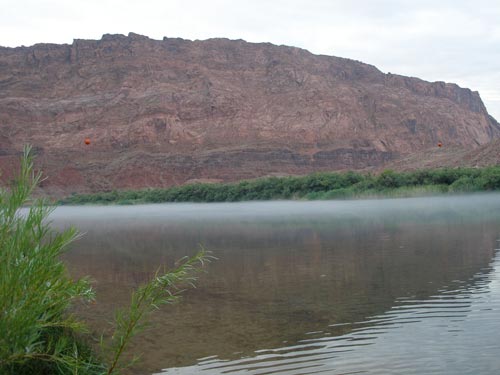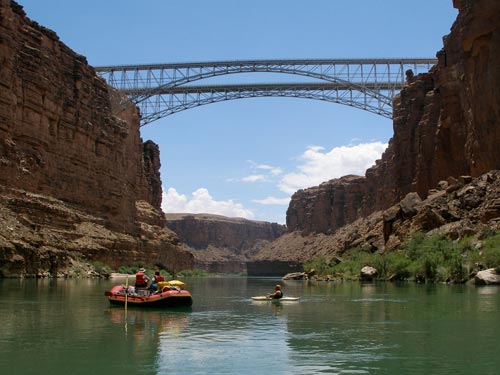- Lee's Ferry to Saltwater Wash (mile 12) -
It had started out as as such a tranquil evening that we hadn't bothered to put the fly on the tent. Unfortunately the rains moved inaround midnight. At first it was just a light sprinkle so we tried to ignore it. But very quickly we realized it was getting steadily worse. We raced about putting the fly on in the dark. By morning, the clouds had started to move on.
We got up at 5:15 am in order to get a demo on the equipment. At 9 am, we got a long safety talk from a park ranger. One of the questions he asked was "What is the most common place that people get bitten by a rattlesnake?" Of course we all said things like foot, leg, etc. Nope. The answer was... hand. Apparently when people actually see a snake, their first instinct it to reach down and touch it. Really??! Hmmm. Well, Darwinism in action, I suppose.
Not doing stupid things is even more important in a place like this since help is sometimes several days away. We did have a satellite phone with us (the current most popular method), but it requires an 80% view of the sky or a line-of-sight with an orbiting satellite. Being surrounded by tall canyon walls makes this tricky, and a rafting party can be days without emergency service.

Morning at the Lee's Ferry campsite

The rising sun hits the Vermillion Cliffs.

Back upstream toward Echo Cliffs, a layer of mist coats the river.
The water was currently green although it was expected to turn brown later on due to our rainstorm last night. The rains pull all sorts of sediment down from the cliffs.
The Grand Canyon offers more than 150 named rapids. River runners divide the canyon into upper and lower sections: the Upper Grand Canyon stretches from Lee's Ferry to Phantom Ranch (87 miles with 19 major rapids) and the Lower Grand Canyon from Phantom Ranch to Whitmore Wash (about 100 miles with some of the largest rapids).

Approaching Paria River Riffle, the first of the rapids. These little ones were extremely fun!

Rounding the bend

A quick glance back
Marble Canyon marks the beginning of the Grand Canyon as well as the western boundary of the Navajo Nation. It was named by Major John Wesley Powell, the leader of the first expedition down the river in 1869, who felt that the polished limestone resembled marble.
The Colorado River has been carving into the Colorado Plateau for the last 17 million years. The resulting gorge, known as the Grand Canyon, is 277 miles long and ranges from 4 to 18 miles wide. The river ranges from 76 to 750 feet wide. In some spots the canyon is more than a mile deep.

The new 1995 Navajo Bridge is the only traffic crossing of the Colorado River for a stretch of 600 miles. The 726-foot long steel arch bridge spans Marble Canyon 470 feet above the river. The old 1929 bridge remains a pedestrian bridge.

The old (front) and new (back) Navajo Bridges
Surprisingly, the canyon was filled with life... not just small critters, but large ones as well.

Under a watchful gaze
The Desert or Nelson Bighorn Sheep is a subspecies of the Rocky Mountain Bighorn Sheep. They are not as stocky as the Rocky Mountain Bighorn and their horns are flatter. They have adapted to desert conditions and can go for extended periods of time without drinking water. They can even lose up to 30 percent of their body weight and still survive.

Both males and females have horns. Older rams have impressive curling horns measuring over 3 feet while ewes have much smaller and lighter horns that tend not to curl.

Incredible canyon views

Ten Mile Rock (so named because it is located at mile 10)
In between the small rapids was lots of slow floating. We were originally going to try for 20 miles but stopped around mile 12 at the Saltwater Wash camp. It was rather hilly and sandy, surrounded by canyon walls.
We spent a bit of time learning where all the food was on the different rafts. We all took turns preparing the meals. Today I was on dinner shift and got to make pasta primavera. The moon was bright and there were tons of stars! The rain clouds had decided to spare us.
Doing dishes involved using a three bucket system... one was warm and sudsy for washing; the next was warm and clean for rinsing; and the last was cold with some bleach for sterilizing.
return • continue

